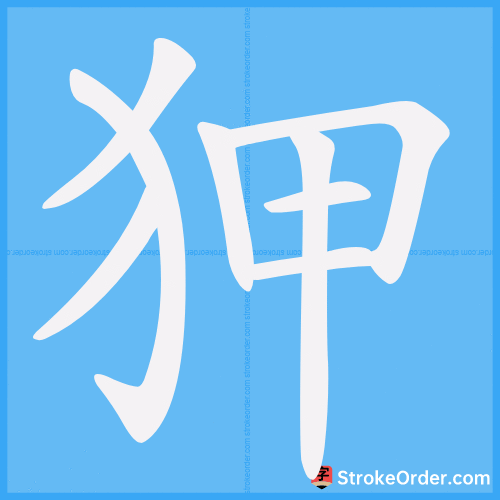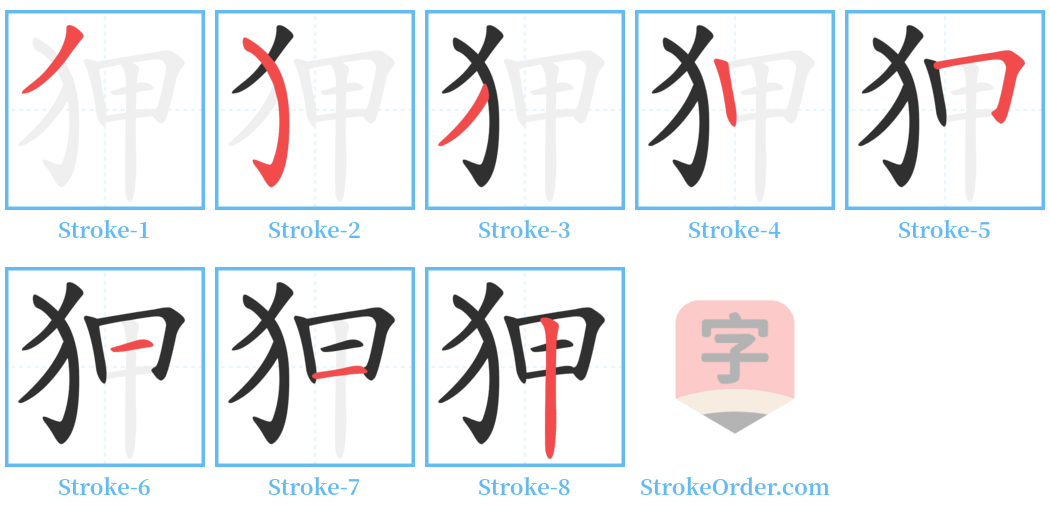狎 Stroke Order
Animated Stroke Order of 狎

Stroke Order Diagrams for 狎

Step-by-Step Handwriting Guide for 狎

Learn to Write Chinese Characters with Video Tutorials
Watch the video of writing the Chinese character "狎", learn the correct stroke order (笔顺) of the character "狎", and master the standard way of writing the character "狎".
Free Printable Handwriting Practice with Stroke Order: 狎
Printable Writing Practice Worksheet of "狎" in Portrait Orientation (Tian Zi Ge)

Printable Writing Practice Worksheet of "狎" in Landscape Orientation (Tian Zi Ge)

Information of 狎
Pinyin
xiá
Radical
犭
Strokes
8 strokes
Usage
★★★★
Definition
be intimate with
狎 [xiá]
动
1. 亲近而态度不庄重。
Be improperly familiar with.
示例:狎侮,狎弄,狎昵,狎客(嫖客)。
2. 习惯。
Habit.
3. 更替。
Alternate.
4. 拥挤。
Crowded.
示例:车骑并狎。
本义: 驯犬。
Original meaning: Tame a dog.
造字法: 形声。从犬,甲声。从犬,犬善与人玩耍。
Method of formation: Phonetic and semantic combination; composed of "dog," implying dogs are good at playing with people.
同本义: 同本义 (Tame).
1. 同本义: Tame.
引用: 《说文》:狎,犬可习也。
Reference: "Shuowen Jiezi": "Xiá, dogs can be trained."
2. 驯养: Domesticate.
引用: 《韩非子》:夫龙之为虫也,柔可狎而骑也。
Reference: "Han Feizi": "The dragon, as a creature, can be tamed and ridden."
3. 亲昵,亲近而不庄重: Be improperly familiar with.
引用:
- 唐· 柳宗元《三戒》:稍近,益狎。
"Tang Dynasty, Liu Zongyuan, 'Three Prohibitions': Being closer leads to being more familiar."
- 清· 刘开《问说》:狎而不甘问焉。
"Qing Dynasty, Liu Kai, 'Inquiry': Familiar but unwilling to ask."
示例:狎游(嬉戏亲昵),狎浪(淫秽放浪),狎侮(轻慢;侮辱)。
4. 亲近;接近: Be close to.
引用: 《论语·乡党》:见齐衰者,虽狎,必变。
Reference: "Analects": "When seeing someone from Qi in decline, even if close, one must change."
示例:狎弄(亲近戏弄),狎近(亲近)。
5. 不重视或不注意: Disregard.
引用: 《谷梁传·襄公二十九年》:礼,君不使无耻,不近刑人,不狎敌。
"Guliang Zhuan": "Rituals prevent the ruler from keeping dishonorable company, approaching criminals, or disregarding enemies."
示例:狎侮(轻视;忽视),狎敌(轻敌)。
6. 交替: Alternate.
引用: 《左传·昭公元年》:自无令王,诸侯逐进,狎主齐盟,其又可壹乎?
Reference: "Zuo Zhuan": "Since there was no commanding king, if the vassals alternate leading and align, how can it be united?"
示例:狎主(交替主持)。
Input Method for 狎
Pinyin
xia2
Wubi
qtlh
Cangjie
khwl
Zhengma
qmki
Four Corner
46250
Unicode
U+72ce
Same Pronunciation Characters